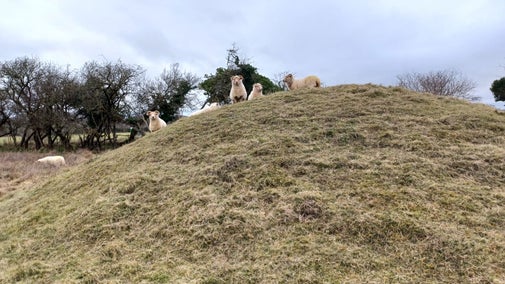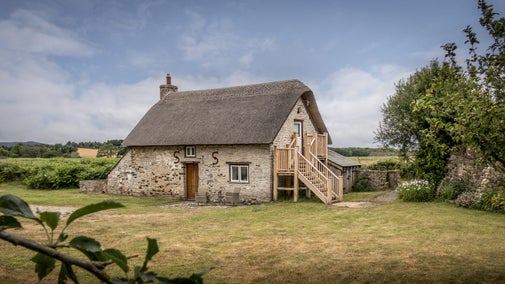
Become a member
Join today and help protect nature, beauty and history – for everyone, for ever. Enjoy access to more than 500 places with National Trust membership.
An Iron Age hill fort in a chalk grassland habitat, which is home to a wealth of wildlife
Blandford Road, Shapwick, Wimborne, Dorset, DT11 9JL

| Asset | Opening time |
|---|---|
| Badbury Rings | Dawn - Dusk |
Badbury Rings is free to visit. Parking is free for National Trust members. There is a car parking charge for non-members of £1.50 for one hour, £2.50 for two hours or £4 all day.
Pay-and-display car park, open dawn till dusk. Free for members; scan your membership card for an all-day ticket. Charges for non-members: £1.50 an hour, £4 all day.
Please keep your dog on a lead between late February and August as there are ground-nesting birds such as skylarks at Badbury Rings. Be aware of grazing livestock; pregnant sheep are often so stressed by dogs running loose that they can abort their young. Dog poo can cause serious harm to livestock, so please pick up and dispose of your dog's poo safely.
Undulating and uneven ground which is steep in places. No toilets. Car park fee for non-members.
Discover how we are protecting the chalk grassland habitat at Badbury Rings through careful use of grazing animals.

Badbury Rings is free to access for everyone. Here are some things you might need to know when you visit.

The paths and fields around Badbury Rings are great for dog walkers. Find out the best places to walk, plus where and why to keep dogs on the lead or under control.

One of Dorset's finest Iron Age hillforts, now home to protected wildlife such as ground-nesting birds and orchids.
Families and dog walkers regularly head to Badbury Rings to explore the ancient Iron Age hillfort, while also enjoying the avenue of beech trees and views of the Dorset countryside.

Enjoy impressive views across the Dorset countryside on this circular walk, while discovering the history, flora and fauna of the Iron Age hillfort of Badbury Rings.

Enjoy a peaceful walk upstream along this picturesque stretch of the Stour river, with ancient woodland and an array of interesting birdlife to observe along the way.

Starting by an 18th-century mill, this moderate walk goes over rough pasture, alongside the River Stour, through the picturesque village of Shapwick and returns on lanes to White Mill.

Walk around the network of droves and along the tree-lined Beech Avenue at Kingston Lacy. This circular trail takes you back along the outskirts of the Kingston Lacy parkland.

Enjoy a gentle walk through the beautiful unspoilt villages of Pamphill and Cowgrove with good views across the Stour Valley.

Enjoy a relaxing circular walk through the water meadows by the River Stour at Kingston Lacy, taking in short stretches on scenic country lanes and along gravel tracks.

Discover the woodland, resident wildlife and historic carriage drive of the Kingston Lacy estate with this circular trail for walkers and cyclists.

Enjoy this gentle circular walk taking you through the beautiful unspoilt village of Pamphill and its wide variety of flora and fauna.

There is no permanent cafe at Badbury Rings. There is a cafe serving a wide range of light lunches, snacks and drinks at Kingston Lacy, c.2 miles down the road.


An eye-catching thatched cottage on the Kingston Lacy estate, where you’ll find miles of footpaths through lush rolling countryside waiting to be explored.

A peaceful site surrounded by grassland and ancient trees on the Kingston Lacy estate, a short stroll from the house and gardens.

A picture-perfect thatch cottage with modern rustic interiors, close to Poole Harbour.

A charming, rustic conversion, this holiday cottage has wonky beams and countryside views.

A cosy cottage attached to the larger farmhouse, with views of open heath and woodland.

A simple campsite in a meadow just off the South West Coast Path, with walks inland to the Purbeck hills or to Chapman’s Pool on the Jurassic Coast.
Sorry, there are no upcoming events at this place
Remnants of the Celtic hillfort can be seen today at this peaceful slice of Dorset countryside, which has sweeping views and good walking trails to explore and enjoy.
Badbury Rings has a history stretching back thousands of years to when Iron Age tribes settled here. Discover the remnants of a Celtic hillfort, overlaid with Roman roads.

As one of only a few chalk downlands in Dorset, Badbury Rings is a haven for many species of wild orchid, butterflies, birds and much more.

Search for live volunteering opportunities, or register your interest with Badbury Rings.


Join today and help protect nature, beauty and history – for everyone, for ever. Enjoy access to more than 500 places with National Trust membership.
By sharing your email address you’re agreeing to receive marketing emails from the National Trust and confirm you’re 18 years old or over. Please see our for more information on how we look after your personal data.